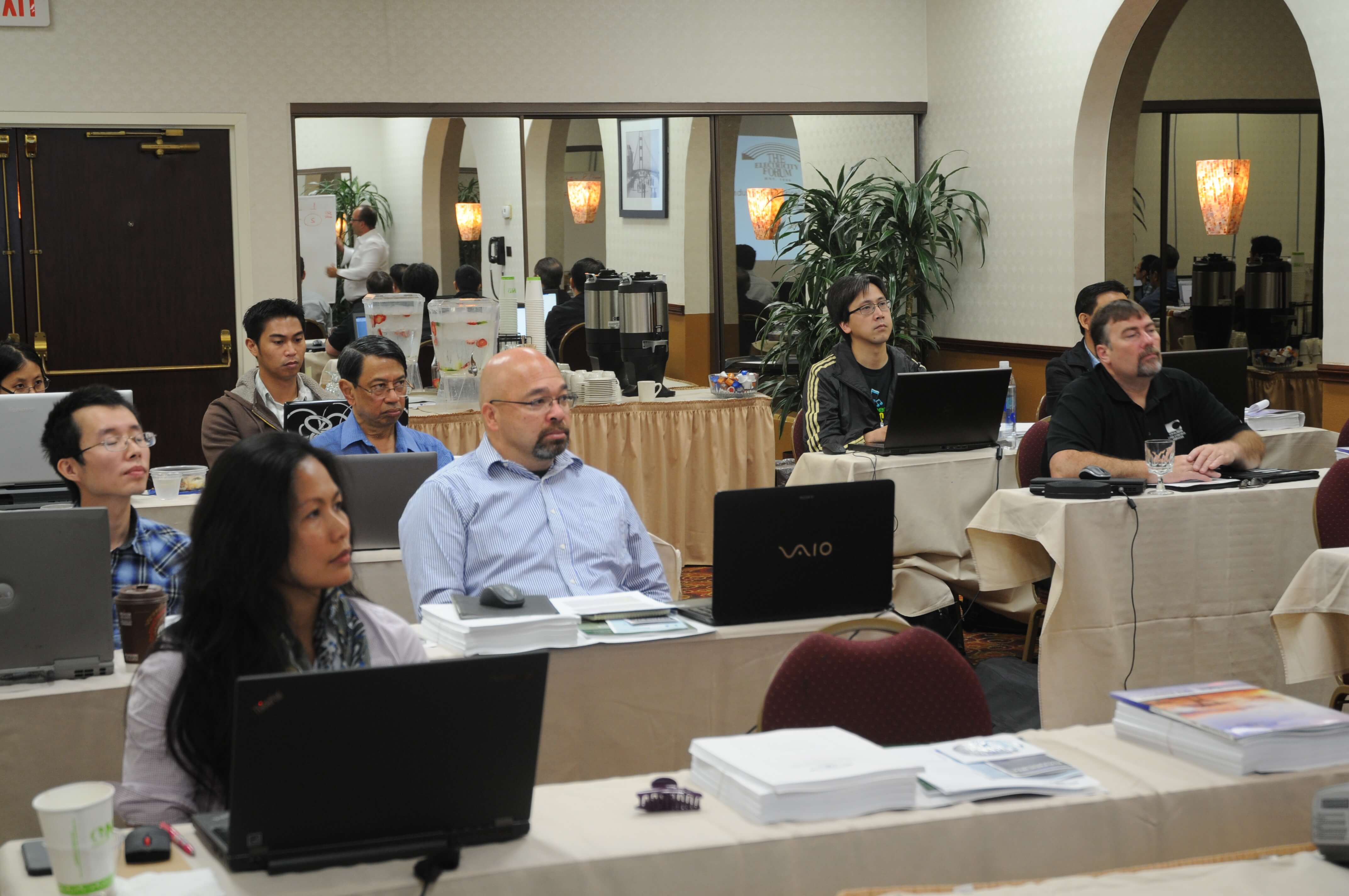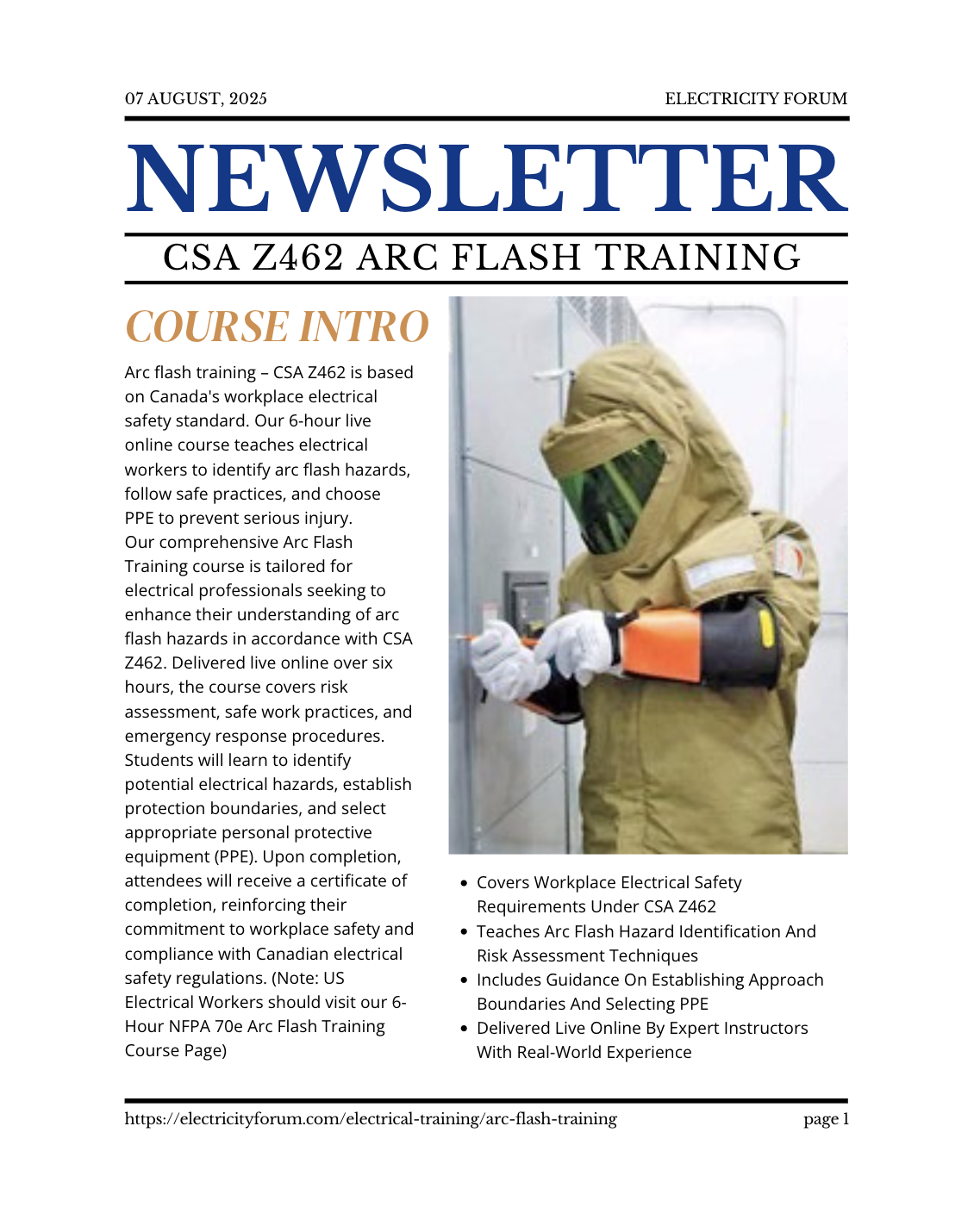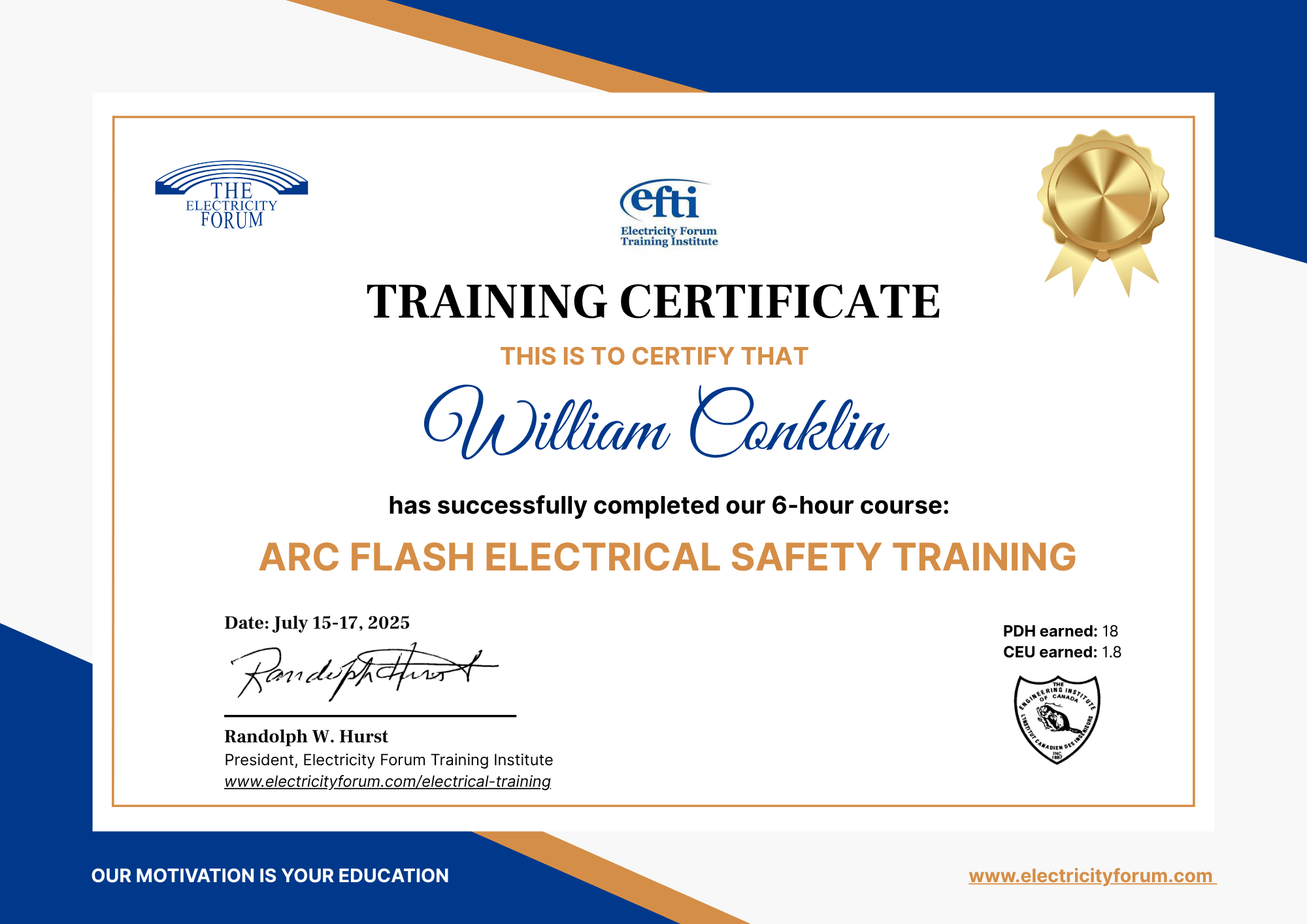This course is recommended for skilled trades, supervisors, and anyone involved in the design, installation, testing and maintenance of electrical protection systems and industrial power circuit breakers.


In-person Group Training

Live Online Group Training
This circuit breaker maintenance training course provides an overview of power system protection design fundamentals, focusing on medium and high voltage power distribution electrical circuit breakers used in common industrial, commerical and institutional applications. Basic electrical circuit breaker construction, electrical safety, and common circuit breaker maintenance techniques are the major components of this course.
The testing and maintenance training part of the course will discuss application, installation, maintenance and testing issues related to low, medium and high-voltage switchgear and electrical circuit breaker equipment. The course will provide delegates with a solid understanding of Circuit Breaker testing and maintenance standards. The course will also make delegates aware of issues concerning the proper application, installation and maintenance of circuit breaker equipment with a strong emphasis on safety. The course will cover a wide range of material starting from the basics and moving on to more complex issues.
When brought on-site, this course can be supplemented by an in-depth study of the specific circuit breaker models used at the client's facility. Hands-on training is provided wherever practical.
Students will learn safe and proper maintenance, testing and safety procedures for servicing a variety of Low Voltage (750V and less) circuit breakers. Topics for Low Voltage circuit breakers will include maintenance and adjustment requirements, as well as insulation resistance, contact resistance and high current primary injection tests.
Students will learn safe and proper maintenance, testing and safety procedures for servicing Medium Voltage (750V – 7.5kV) circuit breakers.
Technically we can include breakers in the MV range of 750-69kV. Most MV services are 12-25kV but Utilities will use up to 38k-69kV that at least we categorized as MV. HV starts at transmission voltages above 69kV and usually was of SF6 GIS equipment breakers include maintenance and adjustment requirements, as well as insulation resistance, contact resistance, high potential and power factor testing. We can provide full reference to a NETA standards and documents here as these are very detailed and inclusive, and publically available
Learning Objectives:
- Use manufacturer instruction literature and established industrial standards to perform required inspection, checks, lubrication and adjustments on Low and Medium voltage circuit breakers.
- How to perform insulation resistance tests on Low and Medium voltage breakers and the interpretation of test data.
- How to perform contact resistance tests on Low and Medium voltage breakers and the interpretation of test data.
- How to perform a high current primary injection test on Low Voltage circuit breakers and the interpretation of test data.
- How to perform a power factor/dissipation test on Medium Voltage breakers and the interpretation of test data.
Live online course schedule
Sign Up For Our Electrical Training Newsletter – Stay Informed!

Who should attend
What you will get






Circuit Breaker Design, Testing and Maintenance
DAY ONE
Session 1: Circuit Breaker Protection Fundamentals
- Why do we need circuit protection?
- Industry standards and differences in build and philosophy ANSI, IEC, NEMA, ETC
- How can protection be achieved?
- Protection of plant and equipment
- Protection of site personnel
- Protection by system design
- Faults (causes, types)
- System arrangements that influence protection (Solidly grounded, Impedance grounded,
Other) Describe the differences advantages and disadvantages.
Session 2: Review: Types of Circuit Breakers
- Molded Case Circuit Breakers
- Insulated Case Circuit Breakers
- Air Circuit Breakers
- Power Circuit Breakers
- Air Magnetic Circuit Breakers
- Vacuum Circuit Breakers
- SF6 Circuit Breakers
- Oil Circuit Breakers
- Air Blast Circuit Breakers
Session 3: Circuit Breaker Maintenance And Testing
- The Need for CB Maintenance
- Qualified Personnel
- Obtaining Spare Parts
- Maintenance Planning
- Description of Components
- Auxiliary CB Equipment
- CB Testing Guidelines
- Testing Specifications
- Insulation Resistance
- Contact Resistance Tests
- Testing the Auxiliary Equipment
Session 4: Circuit Breaker Maintenance And Testing Fundamentals
- Nameplate Data
- Voltage
- Frame Rating
- Description of how the Nameplate data differs from breaker to breaker depending on which standard it was built to
- Continuous Current Rating
- Interrupting Rating
- Control Power
Session 5: Circuit Breaker Maintenance Terminology
- Momentary duty
- Interrupting duty
- Continuous current rating
- Voltage class
- Interrupting medium (air, vacuum, gas)
- Arc chute
- Shunt trip
- Under voltage release
- Racking interlock
- Shutters
- Fixed breakers
- Drawout design
- Cradle and racking mechanism maintenance
- Visual inspection
- Mechanical inspection
- Electrical tests
- Contact resistance
- Power factor testing
- AC/DC insulation resistance testing
- NETA recommended testing for potential test voltages
- Primary current injection (LV breakers) testing
- Secondary current injection testing
- Trip unit test sets
- Timing tests
- Oil and gas sampling testing
- NETA recommended circuit breaker testing schedule
- Circuit breaker communications and connectivity
DAY TWO
Circuit Breaker Maintenance And Testing
Session 6: Circuit Breaker Components
- Main Stabs or Disconnects
- Auxiliary Stabs or Secondary Disconnects
- Ground Stab
- Interference Interlock
- Seismic Positioner
- Cell Switch
- Bell Alarm and Lockout
- Undervoltage Trip Device
- High-Fault Protectors
- Blown Fuse Indicators
- Padlocking Device
- Arcing Contacts
- Intermediate or Secondary Contacts
- Main Contacts
- Auxiliary Contacts
- Arc Chutes
Session 7: Low Voltage Circuit Breaker Testing and Maintenance
- Vacuum Technology Limitations
- Testing Philosophy
- Testing Procedures
- Testing Tips and Tricks
- Switchgear Testing (Physical demonstration with test equipment to show Secondary/Primary testing techniques)
and documentation and reporting hands on. - Trip unit identification (Series Trip/Static Trip)
- Trip unit Retro-Fitting Example, USR relay to AC PRO relay
- Trip unit Testing
- Trip unit Retro-Fitting
- Mechanical Lockout and isolation
Session 8: Standard tests for Medium Voltage and High Voltage Breakers (with live and dead tank design)
- Static contact resistance test (micro-ohm measurement)
- Timing analysis
- Coil and motor current analysis
- Minimum pick-up test
- Undervoltage condition test
- Demonstration with sample test set to show testing done on legacy induction relay, later version solid state, and current version solid state vercurrent protection relays that are used in conjunction with these breakers
Session 9: Electrical Safety Procedures
- General Arc Flash safety precautions and the use of ppe as per CSA Z462-18
- Principles of personnel authorization
- Operator safety training for safe operation of circuit breakers
- Isolation in a circuit breaker context
- Electrical Safety documentation
- Safe working practices when performing breaker racking
- Leveraging technology to remotely operate and rack the circuit breakers Racking devices, communication networks etc. To avoid arc flash hazards
COURSE TIMETABLE
Both days:
Start: 8:00 a.m.
Coffee Break: 10:00 a.m.
Lunch: 12:00 noon
Restart: 1:15 p.m.
Finish: 4:30 p.m.

Live online course registration fees & CEU credits
What you will get






Download free discount coupon
Enter Your Information
Fill out the form below with your name and email address.
Receive Your Coupon
Check your email for a message with a link to your $50 discount coupon.
Register for the Course
Use the coupon code when you sign up for the Advanced Electrical Safety Training course to save $50 off the regular price.

Group Offer
Register 3, Get 1 Free
Register 3 delegates at the full price of $249 each and get the 4th registration free! Perfect for companies, safety departments, and teams looking to train multiple employees at once.
Earn Continuing Education Unit (CEU) Credits
- Successful completion of this course qualifies delegates to receive a certificate of course completion with indicated CEUs.
- CEUs are granted by the Engineering Institute of Canada.
- One CEU is equivalent to 10 professional development hours of instruction.
- This course earns 0.6 CEUs.

Request a free training quote – Live Online & In-Person Group Training
Whether you choose live online or in-person instruction, our electrical training can be customized to your needs and delivered to your team at one or multiple locations.
Our instructors will work with you to assess your team's skills and tailor the training to match your requirements.
Complete this handy form and I will send you a FREE written Quotation on any electrical training you need! Or send me an email and I will contact you to discuss your electrical training requirements Today!
Get the 2026 Live Online Training Catalog
Explore 50+ live, expert-led electrical training courses – interactive, flexible, CEU-certified.
Download Catalog
Download Course Brochure
Get detailed information about this course in our comprehensive brochure.
Download Brochure (PDF)Download free discount coupon
Enter Your Information
Fill out the form below with your name and email address.
Receive Your Coupon
Check your email for a message with a link to your $50 discount coupon.
Register for the Course
Use the coupon code when you sign up for the Advanced Electrical Safety Training course to save $50 off the regular price.

Group Offer
Register 3, Get 1 Free
Register 3 delegates at the full price of $249 each and get the 4th registration free! Perfect for companies, safety departments, and teams looking to train multiple employees at once.



